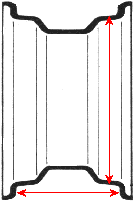|
|
Rims
The wheel rim is constructed in such a way that the tyre can almost only be mounted by a machine. It keeps the (tubeless) tyre on its seat without losing air under all driving conditions. Modern wheel rims can contain
emergency driving systems in the event of pressure loss.
The wheel rim bowl is connected with several screws to the wheel hub flange, or it is centrally bolted together, e.g., in racing vehicles. It is connected with the disc wheel which carries the tyre. To allow the assembly of
a tyre, on the outdated triplex rim, the disc wheel is divided into three parts around the circumference, or has a deep bed or a one-sided removable rim flange. Two
disc wheel halves are
more seldom, they are provided with a sealing and are screwed together with the bowl. Standard nowadays, also in utility vehicles, (as a high-shoulder wheel-rim) is the one-piece drop-centre rim. In this case, the
deep bed allows the mounting of tubeless tyres. A circumferential bead (hump) is mostly pressed into both sides of the deep bed, and prevents the tyre from slipping off and suddenly losing air even when high
cornering forces occur.
 | 8½Jx15 Lk 5x108x65 ET 38 |
| 8½ | Rim width in inches |
| J | Rim flange |
| x | Drop-center rim |
| 15 | Rim diameter in inches |
| 5 | Number of wheel studs |
| 108 | Diameter of the stud-hole circumference in mm |
| 65 | Hub diameter in mm |
| 38 | Rim-offset in mm |
Important for the mounting is the stud-hole circumference. It is described through the centre of each stud-hole. Basically, the studs and the stud holes must correspond one hundred percent with each other. However,
nowadays, there is the offset screwing, with which a difference of approx. 2 mm can possibly be compensated. In addition however, suitable centering rings (synthetic) are absolutely necessary to avoid off-centre
imbalance. Alterations in the number of holes and/or larger stud-hole circumference differences can be compensated, perhaps, with so-called adaptor plates. However, in this case the correct length of the wheel bolts
and the possible changing of the wheel-track must be taken into consideration. This can possibly be compensated by the choice of a different rim-offset.
12/09
|
|